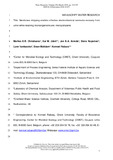JavaScript is disabled for your browser. Some features of this site may not work without it.
| dc.contributor.author | Christiaens, Marlies E. R. | |
| dc.contributor.author | Udert, Kai M. | |
| dc.contributor.author | Arends, Jan B. A. | |
| dc.contributor.author | Huysman, Steve | |
| dc.contributor.author | Vanhaecke, Lynn | |
| dc.contributor.author | McAdam, Ewan | |
| dc.contributor.author | Rabaey, Korneel | |
| dc.date.accessioned | 2018-12-12T15:52:44Z | |
| dc.date.available | 2018-12-12T15:52:44Z | |
| dc.date.issued | 2018-11-30 | |
| dc.identifier.citation | Christiaens ME, Udert KM, Arends JB, et al., Membrane stripping enables effective electrochemical ammonia recovery from urine while retaining microorganisms and micropollutants. Water Research, Volume 150, March 2019, pp. 349-357 | en_UK |
| dc.identifier.issn | 0043-1354 | |
| dc.identifier.uri | https://doi.org/10.1016/j.watres.2018.11.072 | |
| dc.identifier.uri | http://dspace.lib.cranfield.ac.uk/handle/1826/13729 | |
| dc.description.abstract | Ammonia recovery from urine avoids the need for nitrogen removal through nitrification/denitrification and re-synthesis of ammonia (NH3) via the Haber-Bosch process. Previously, we coupled an alkalifying electrochemical cell to a stripping column, and achieved competitive nitrogen removal and energy efficiencies using only electricity as input, compared to other technologies such as conventional column stripping with air. Direct liquid-liquid extraction with a hydrophobic gas membrane could be an alternative to increase nitrogen recovery from urine into the absorbent while minimizing energy requirements, as well as ensuring microbial and micropollutant retention. Here we compared a column with a membrane stripping reactor, each coupled to an electrochemical cell, fed with source-separated urine and operated at 20 A m−2. Both systems achieved similar nitrogen removal rates, 0.34 ± 0.21 and 0.35 ± 0.08 mol N L−1 d−1, and removal efficiencies, 45.1 ± 18.4 and 49.0 ± 9.3%, for the column and membrane reactor, respectively. The membrane reactor improved nitrogen recovery to 0.27 ± 0.09 mol N L−1 d−1 (38.7 ± 13.5%) while lowering the operational (electrochemical and pumping) energy to 6.5 kWhe kg N−1 recovered, compared to the column reactor, which reached 0.15 ± 0.06 mol N L−1 d−1 (17.2 ± 8.1%) at 13.8 kWhe kg N−1. Increased cell concentrations of an autofluorescent E. coli MG1655 + prpsM spiked in the urine influent were observed in the absorbent of the column stripping reactor after 24 h, but not for the membrane stripping reactor. None of six selected micropollutants spiked in the urine were found in the absorbent of both technologies. Overall, the membrane stripping reactor is preferred as it improved nitrogen recovery with less energy input and generated an E. coli- and micropollutant-free product for potential safe reuse. Nitrogen removal rate and efficiency can be further optimized by increasing the NH3 vapor pressure gradient and/or membrane surface area. | en_UK |
| dc.language.iso | en | en_UK |
| dc.publisher | Elsevier | en_UK |
| dc.rights | Attribution-NonCommercial-NoDerivatives 4.0 International | * |
| dc.rights.uri | http://creativecommons.org/licenses/by-nc-nd/4.0/ | * |
| dc.subject | membrane | en_UK |
| dc.subject | micropollutant | en_UK |
| dc.subject | nutrient recovery | en_UK |
| dc.subject | pathogen | en_UK |
| dc.subject | stripping | en_UK |
| dc.subject | urine | en_UK |
| dc.title | Membrane stripping enables effective electrochemical ammonia recovery from urine while retaining microorganisms and micropollutants | en_UK |
| dc.type | Article | en_UK |
Files in this item
The following license files are associated with this item:
This item appears in the following Collection(s)
-
Staff publications (SWEE) [2827]

